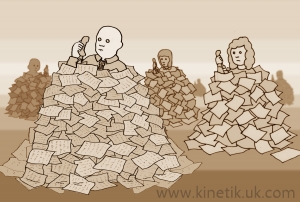
How a Clean Workspace Makes All the Difference: Systematic Clearing-Out
What is the connection between systematic ‘clearing out’ or uncluttering physical and electronic information and transformational change?
We’ve all heard this line before: “I’m too busy right now.” This tired excuse is often used to resist change that can make a big impact. Take, for example, uncluttering your life. Frequently, the benefits of such clear-outs are not immediately evident. In reality, uncluttering your everyday routine and creating ‘space’ can not only cultivate new strategies, but also can frequently unearth important information buried deep within old documents.
There is often a structural disconnect in companies, wherein executives will implement strategic transformational change, while the staff might still be using old strategies and information. So, a good time for a clear-out is at the introduction of the process. This way, both the staff and the executives can be on the same page about the new values and processes that are being implemented. (You can read more about value creation here: http://ow.ly/XBfET)
Additionally, during a clear out, hidden gems can surface. These are important information that have been forgotten, due to the untidy environment. The hidden gems can shorten or change whole processes in general.
The multinational car brand Audi has recently implemented a clean desk policy, encouraging workers to clear their desks at the end of the day. Executive vice president Johan de Nysschen said regarding the policy: “We want to create a sophisticated atmosphere. It’s conducive towards organisation.”[1] Sometimes, disorganisation can lead to even more disarray. An employee is more likely to throw his or her papers in a pile rather than putting it in the right folder if all the other information is also in a pile on the floor. This is because the work environment sets the tone for all work procedures.
How can we stop this vicious cycle of messiness? Regularly scheduled clear-outs can help. However, it is also important to keep in mind that being tidy has nothing to do with individual habits. Organisations should allow for individual working styles and allow employees to create a comfortable workspace.
Regular clear-out are an essential aspect of the “Lean” working method invented by Toyota [2]. The company uses a “5S” method:
- Sorting: Sorting among ‘frequently used,’ ‘may prove important’ and ‘not useful/to be discarded’
- Set in Order: Making sure all materials are organised neatly, according to their order of use
- Shine and Secure: Everyone leaves the office as they find it. This will allow the clear-out to be effective for a longer period of time, and help out new employees understand what is where faster.
- Standardise: Have a standard procedure clearly written out to sort, set in order, and shine and secure.
- Sustain: These elements should be embedded within the culture of the organisation so that it would occur naturally, rather than as a top-down approach.
How can a leader get their employees to follow such a method? Having allotted teams to clear out certain sections can help motivate the employees. Teams can be formed according to the department, or it can be left to the employees to form groups. To make the clear-out exciting, it can be combined with a theme, such as a dress down day. Each team would sort and set the workplace in order, followed by a ‘town meeting’ where they share their ideas about why they organised the workplace the way they did. This will help exchange ideas and also standardise the new procedures. Warby Parker, the online prescription glass seller, has embedded these habits in their company culture. They say that this helps the company to be a team and work together[3].
It is not just papers and documents that get cluttered. In today’s digital age, often shared folders, emails and internal communication systems get messy very easily. It is thus important to implement a digital clear-out as well as a physical one. This will allow employees to know instinctively where information is, what is missing and what can be done to improve. It is easier to understand where to go when one knows what they already have. A digital clear-out will also make the IT team happy by opening new storage space, which might increase the electronic processing time and help them to be more efficient.
In brief, a clear-out can help an organisation by increasing morale and productivity in the workplace, and also it can be turned into an activity that builds team spirit. It’s the little difference that can end up leading to a big change.
The techniques listed above and those detailed in The Art of Transformational Change offer managers the opportunity to learn important lessons, avoid mistakes and apply the right practice when it comes to change.
Ketan Varia, with editorial support from Jessica Prupas and Burcu Atay
[1] http://archive.fortune.com/2008/10/06/news/companies/kimes_audi.fortune/index.htm
[2] Jeffrey Liker, ‘The Toyota Way’ (New York: McGraw Hill, 2004)

